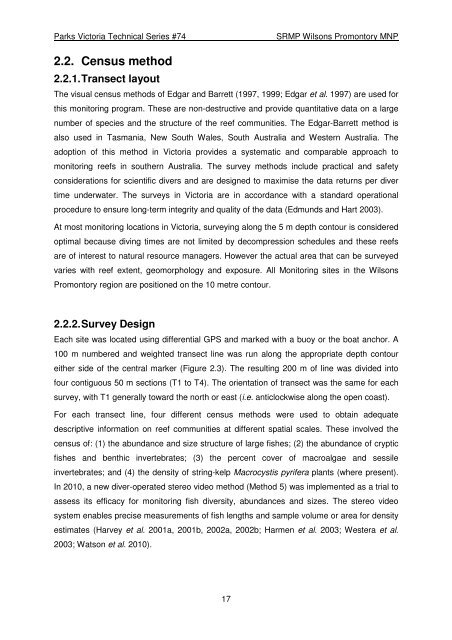the reef biota at Wilsons promontory marine national - Parks Victoria
the reef biota at Wilsons promontory marine national - Parks Victoria
the reef biota at Wilsons promontory marine national - Parks Victoria
- No tags were found...
You also want an ePaper? Increase the reach of your titles
YUMPU automatically turns print PDFs into web optimized ePapers that Google loves.
<strong>Parks</strong> <strong>Victoria</strong> Technical Series #74SRMP <strong>Wilsons</strong> Promontory MNP2.2. Census method2.2.1. Transect layoutThe visual census methods of Edgar and Barrett (1997, 1999; Edgar et al. 1997) are used forthis monitoring program. These are non-destructive and provide quantit<strong>at</strong>ive d<strong>at</strong>a on a largenumber of species and <strong>the</strong> structure of <strong>the</strong> <strong>reef</strong> communities. The Edgar-Barrett method isalso used in Tasmania, New South Wales, South Australia and Western Australia. Theadoption of this method in <strong>Victoria</strong> provides a system<strong>at</strong>ic and comparable approach tomonitoring <strong>reef</strong>s in sou<strong>the</strong>rn Australia. The survey methods include practical and safetyconsider<strong>at</strong>ions for scientific divers and are designed to maximise <strong>the</strong> d<strong>at</strong>a returns per divertime underw<strong>at</strong>er. The surveys in <strong>Victoria</strong> are in accordance with a standard oper<strong>at</strong>ionalprocedure to ensure long-term integrity and quality of <strong>the</strong> d<strong>at</strong>a (Edmunds and Hart 2003).At most monitoring loc<strong>at</strong>ions in <strong>Victoria</strong>, surveying along <strong>the</strong> 5 m depth contour is consideredoptimal because diving times are not limited by decompression schedules and <strong>the</strong>se <strong>reef</strong>sare of interest to n<strong>at</strong>ural resource managers. However <strong>the</strong> actual area th<strong>at</strong> can be surveyedvaries with <strong>reef</strong> extent, geomorphology and exposure. All Monitoring sites in <strong>the</strong> <strong>Wilsons</strong>Promontory region are positioned on <strong>the</strong> 10 metre contour.2.2.2. Survey DesignEach site was loc<strong>at</strong>ed using differential GPS and marked with a buoy or <strong>the</strong> bo<strong>at</strong> anchor. A100 m numbered and weighted transect line was run along <strong>the</strong> appropri<strong>at</strong>e depth contourei<strong>the</strong>r side of <strong>the</strong> central marker (Figure 2.3). The resulting 200 m of line was divided intofour contiguous 50 m sections (T1 to T4). The orient<strong>at</strong>ion of transect was <strong>the</strong> same for eachsurvey, with T1 generally toward <strong>the</strong> north or east (i.e. anticlockwise along <strong>the</strong> open coast).For each transect line, four different census methods were used to obtain adequ<strong>at</strong>edescriptive inform<strong>at</strong>ion on <strong>reef</strong> communities <strong>at</strong> different sp<strong>at</strong>ial scales. These involved <strong>the</strong>census of: (1) <strong>the</strong> abundance and size structure of large fishes; (2) <strong>the</strong> abundance of crypticfishes and benthic invertebr<strong>at</strong>es; (3) <strong>the</strong> percent cover of macroalgae and sessileinvertebr<strong>at</strong>es; and (4) <strong>the</strong> density of string-kelp Macrocystis pyrifera plants (where present).In 2010, a new diver-oper<strong>at</strong>ed stereo video method (Method 5) was implemented as a trial toassess its efficacy for monitoring fish diversity, abundances and sizes. The stereo videosystem enables precise measurements of fish lengths and sample volume or area for densityestim<strong>at</strong>es (Harvey et al. 2001a, 2001b, 2002a, 2002b; Harmen et al. 2003; Westera et al.2003; W<strong>at</strong>son et al. 2010).17

















